Target
Halve the gap in employment outcomes between Indigenous and non‑Indigenous Australians within a decade (by 2018)
Key points
- In 2018, the Indigenous employment rate was around 49 per cent compared to around 75 per cent for non-Indigenous Australians.
- Over the past decade (2008–2018), the employment rate for Indigenous Australians increased slightly (by 0.9 percentage points), while for non‑Indigenous Australians it fell by 0.4 percentage points. As a result, the gap has not changed markedly.
- The Indigenous employment rate varied by remoteness. Major Cities had the highest employment rate at around 59 per cent compared to around 35 per cent in Very Remote areas. The gap in employment outcomes between Indigenous and non-Indigenous Australians was widest in Remote and Very Remote Australia.
What the data tells us
National
The target to halve the gap in employment outcomes within a decade was not met.
Participation in employment provides financial and economic security and assists in opening the door to self-determination. Employment status also has associations with outcomes for health, social and emotional wellbeing, and living standards (Bambra 2011; Gray et al. 2014; Marmot 2015).
Progress against this target is measured using data from the National Aboriginal and Torres Strait Islander Health Survey (NATSIHS) 2018–19,1 based on the proportion of Indigenous Australians aged 15–64 years who are employed (employment-to-population ratio, referred to herein as the employment rate).
In order to consistently compare the employment rate, the Community Development Employment Projects (CDEP) program has been excluded from this analysis. Under the CDEP, participants were classified as employed on the basis of being paid wages (derived from income support) for activities or training. The CDEP was phased out before the 2014–15 NATSIHS. Job seekers are now supported through the Community Development Program (CDP)2 (in Remote and Very Remote areas), jobactive and Disability Employment Services, and are not classified as employed by the Australian Bureau of Statistics.
The employment rate for Indigenous Australians has remained relatively stable over the past decade. Between 2008 and 2018–19, the national Indigenous employment rate increased slightly from 48.2 per cent to 49.1 per cent (Figure 6.1).3 The employment rate for non‑Indigenous Australians over the same period remained relatively stable at around 75 per cent.4
The enablers and barriers to Indigenous Australians’ participation in employment are multiple and intertwined with social, cultural, geographic and economic factors. Acquiring skills—particularly literacy, numeracy and digital problem solving skills—is associated with better labour market outcomes (OECD 2019). For those Indigenous Australians with higher levels of education, there was virtually no gap in employment rates with non-Indigenous Australians (AHMAC 2017).5
Many Indigenous Australians face a conflict between family responsibilities, which are seen as a primary obligation, and the requirements associated with finding and keeping a job (Venn and Biddle 2018). Major chronic diseases and fair/poor self-assessed health status have a strong negative relationship with participation in the labour force (Belachew and Kumar 2014).

Sources: Australian Bureau of Statistics, Unpublished and 2016, National Aboriginal and Torres Strait Islander Social Survey 2008 and 2014–15, Unpublished and Cat. no. 4714.0; Australian Bureau of Statistics, 2014, Australian Aboriginal and Torres Strait Islander Health Survey: Updated Results 2012–13, Cat. no. 4727.0.55.006; Australian Bureau of Statistics, 2019, National Aboriginal and Torres Strait Islander Health Survey, Cat. no. 4715.0; Australian Bureau of Statistics 2008, 2012, 2014 and 2018, Education and Work, Australia May 2008, 2012, 2014 and 2018, Cat. no. 6227.0.
Notes:
- Confidence intervals reflect the level of uncertainty associated with the measurement of employment rates. They define a range of values within which the actual level of employment is likely to lie.
- The target is based on the employment gap in 2008 (including the CDEP component).
View the text alternative for Figure 6.1.
States and territories
The target to halve the gap in employment outcomes within a decade was not met in any state or territory.
Employment rates for Indigenous Australians increased in New South Wales and the Northern Territory,6 while other jurisdictions experienced a decline over the past decade7 (Figure 6.2).
Since 2008, the Indigenous employment rate in the Northern Territory increased from around 33 per cent to 37 per cent8, reducing the gap by around 4 percentage points. In New South Wales, employment rates increased from around 45 per cent to 54 per cent, reducing the gap by around 9 percentage points. The gap widened in the remaining jurisdictions (Figure 6.3).

Sources: Australian Bureau of Statistics, National Aboriginal and Torres Strait Islander Social Survey 2008, Unpublished, ABS: Canberra; Australian Bureau of Statistics, 2019, Australian Aboriginal and Torres Strait Islander Health Survey 2018–19, Cat. no. 4715.0, ABS: Canberra.
Notes:
- Confidence intervals reflect the level of uncertainty associated with the measurement of employment rates. They define a range of values within which the actual level of employment is likely to lie.
- The target is based on the employment gap in 2008 (including the CDEP component).
View the text alternative for Figure 6.2.
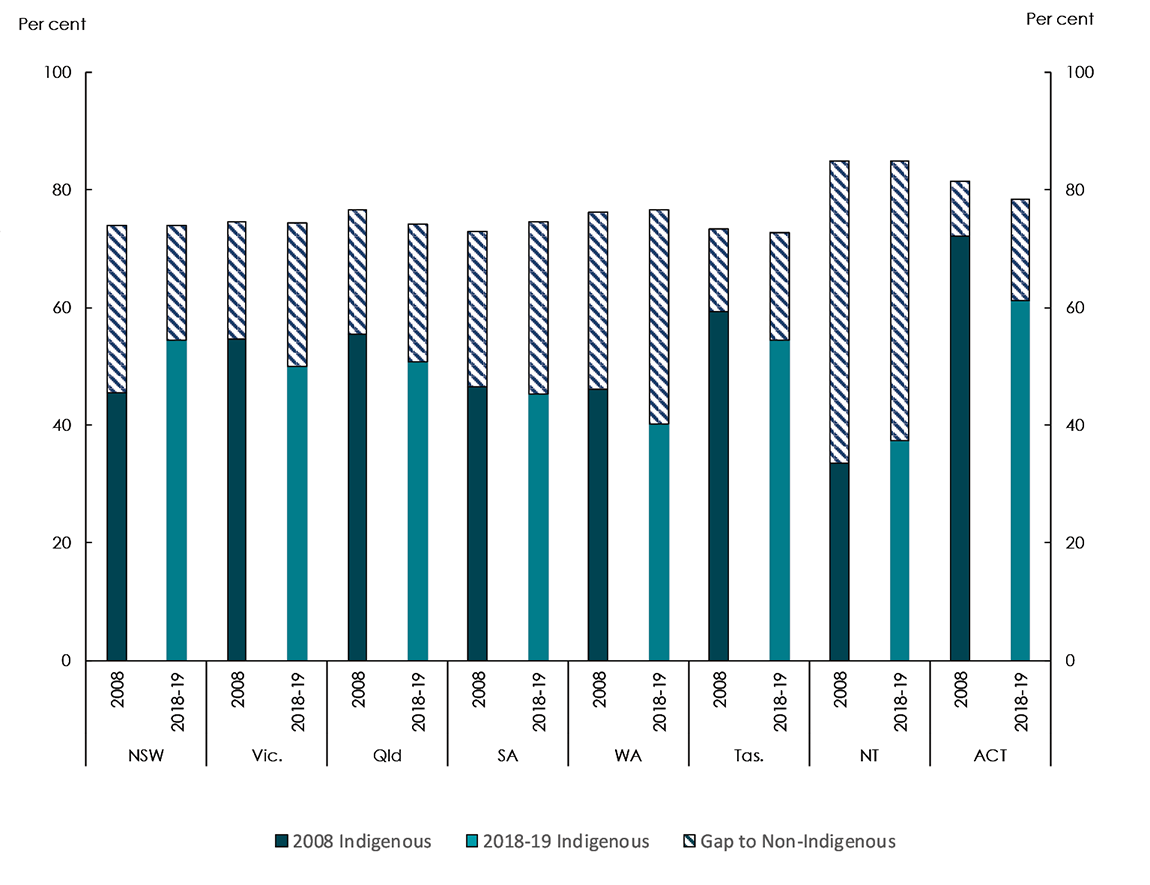
Sources: Australian Bureau of Statistics, National Aboriginal and Torres Strait Islander Social Survey 2008, Unpublished, ABS: Canberra; Australian Bureau of Statistics, 2019, Australian Aboriginal and Torres Strait Islander Health Survey 2018–19, Cat. no. 4715.0 ABS: Canberra; Australian Bureau of Statistics 2008 and 2018, Education and Work, Australia, May 2008 and 2018, Cat. no. 6227.0, ABS: Canberra.
View the text alternative for Figure 6.3.
Remoteness
The Indigenous employment rate varied considerably by remoteness. In 2018–19, the Indigenous employment rate was highest in Major Cities (around 59 per cent) and lowest in Very Remote areas (around 35 per cent).9
There has been limited movement in the employment rate by remoteness over the past decade. The largest changes were in Outer Regional areas where there was a decrease of around 11 percentage points. In Very Remote areas, the employment rate increased by around 6 percentage points (Figure 6.4).10
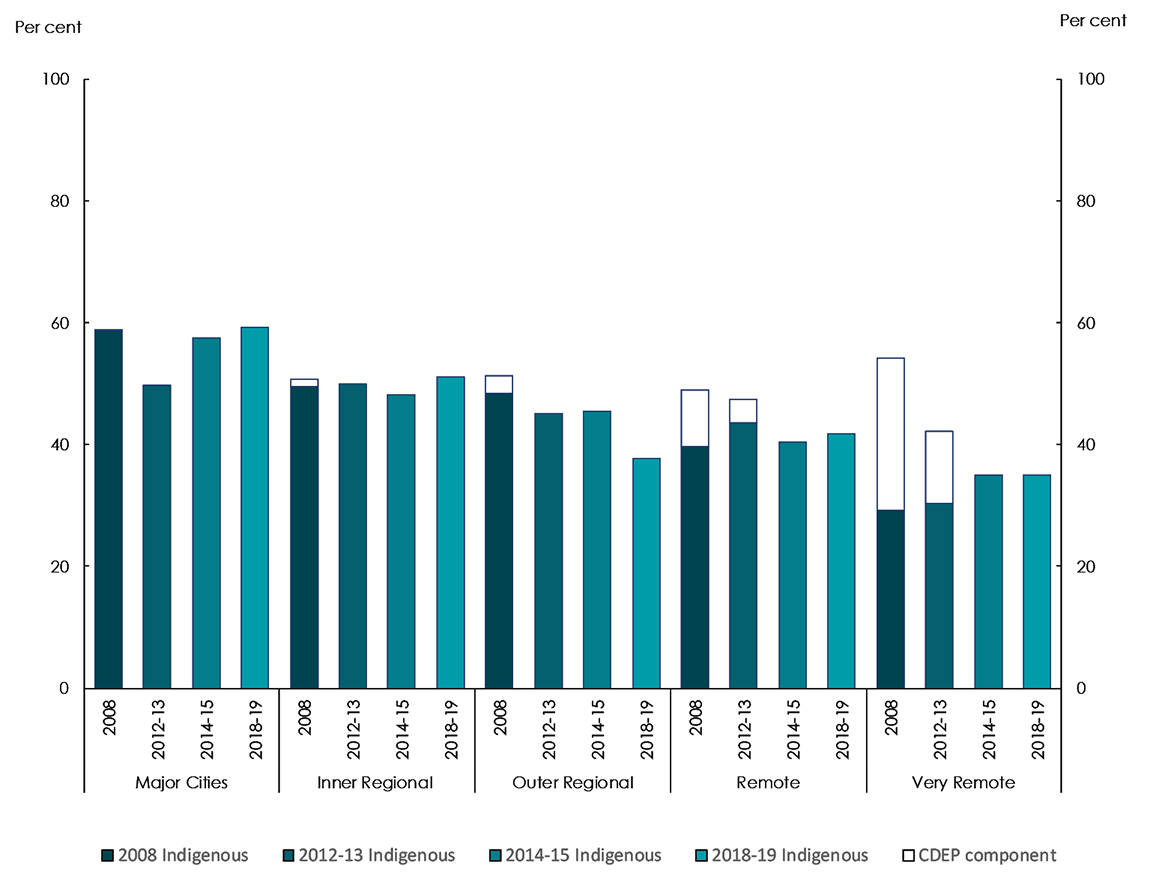
Sources: Australian Bureau of Statistics, Unpublished and 2016, National Aboriginal and Torres Strait Islander Social Survey 2008 and 2014–15, Unpublished and Cat. no. 4714.0, ABS: Canberra; Australian Bureau of Statistics 2014, Australian Aboriginal and Torres Strait Islander Health Survey: Updated Results 2012–13, Cat. no. 4727.0.55.006, ABS: Canberra; Australian Bureau of Statistics 2019, National Aboriginal and Torres Strait Islander Health Survey, Cat. no. 4715.0, ABS: Canberra.
View the text alternative for Figure 6.4.
There was less variation by remoteness for the non‑Indigenous employment rate and consequently the gap widens with remoteness (Figure 6.5). The largest gap was in Very Remote areas where the Indigenous employment rate was around 49 percentage points less than the non-Indigenous employment rate. The smallest gap was in Major Cities (around 15 percentage points).
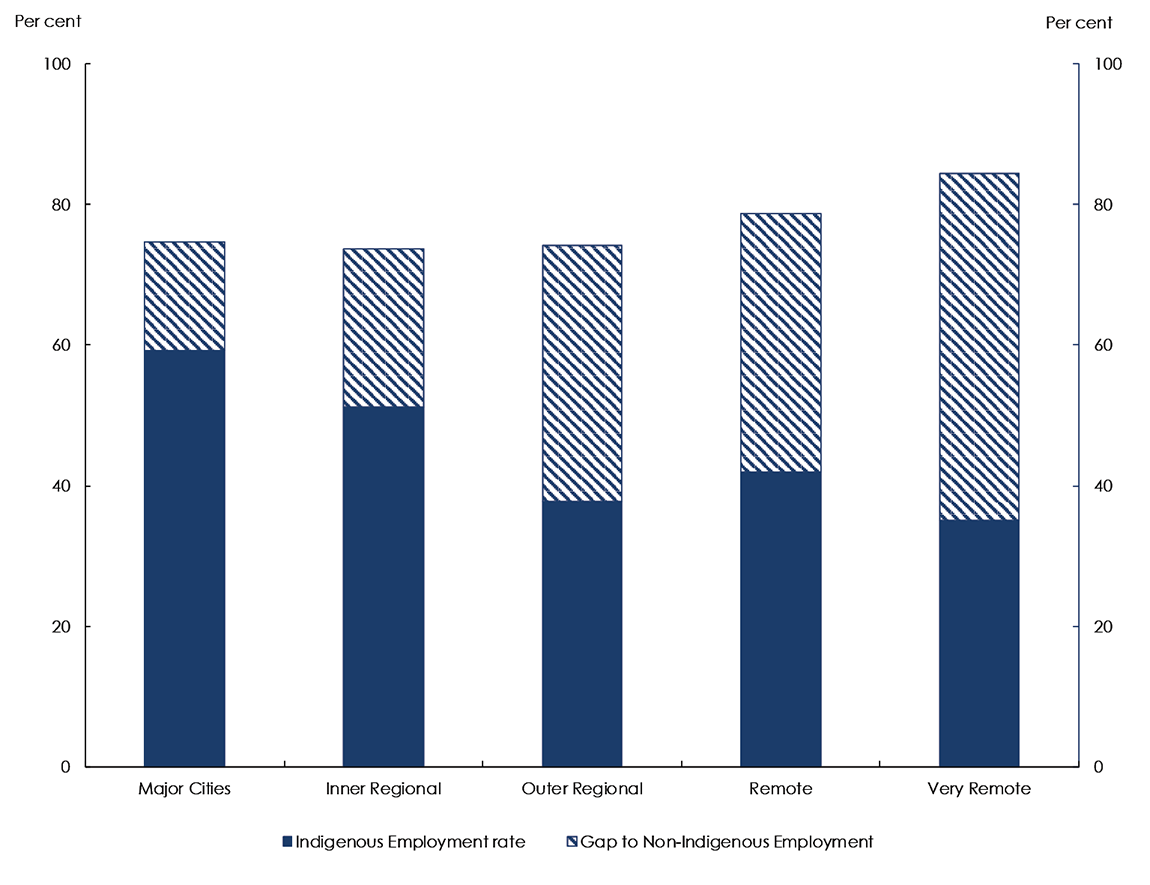
Sources: Australian Bureau of Statistics 2019, Australian Aboriginal and Torres Strait Islander Health Survey 2018–19, Cat. no. 4715.0 ABS: Canberra; Australian Bureau of Statistics 2018, Education and Work, Australia, May 2018, Cat. no. 6227.0, ABS: Canberra.
View the text alternative for Figure 6.5.
There are exceptions to the pattern of employment rates by remoteness (Figure 6.5). The most noticeable exception was in Remote South Australia with an Indigenous employment rate of around 67 per cent—the highest in Remote Australia. This was twice the Indigenous employment rate for Inner Regional South Australia (around 33 per cent), and higher than Major Cities (around 45 per cent). In contrast, the Indigenous employment rate was highest in Inner Regional Queensland (around 60 per cent) (Figure 6.6 and Figure 6.7).11
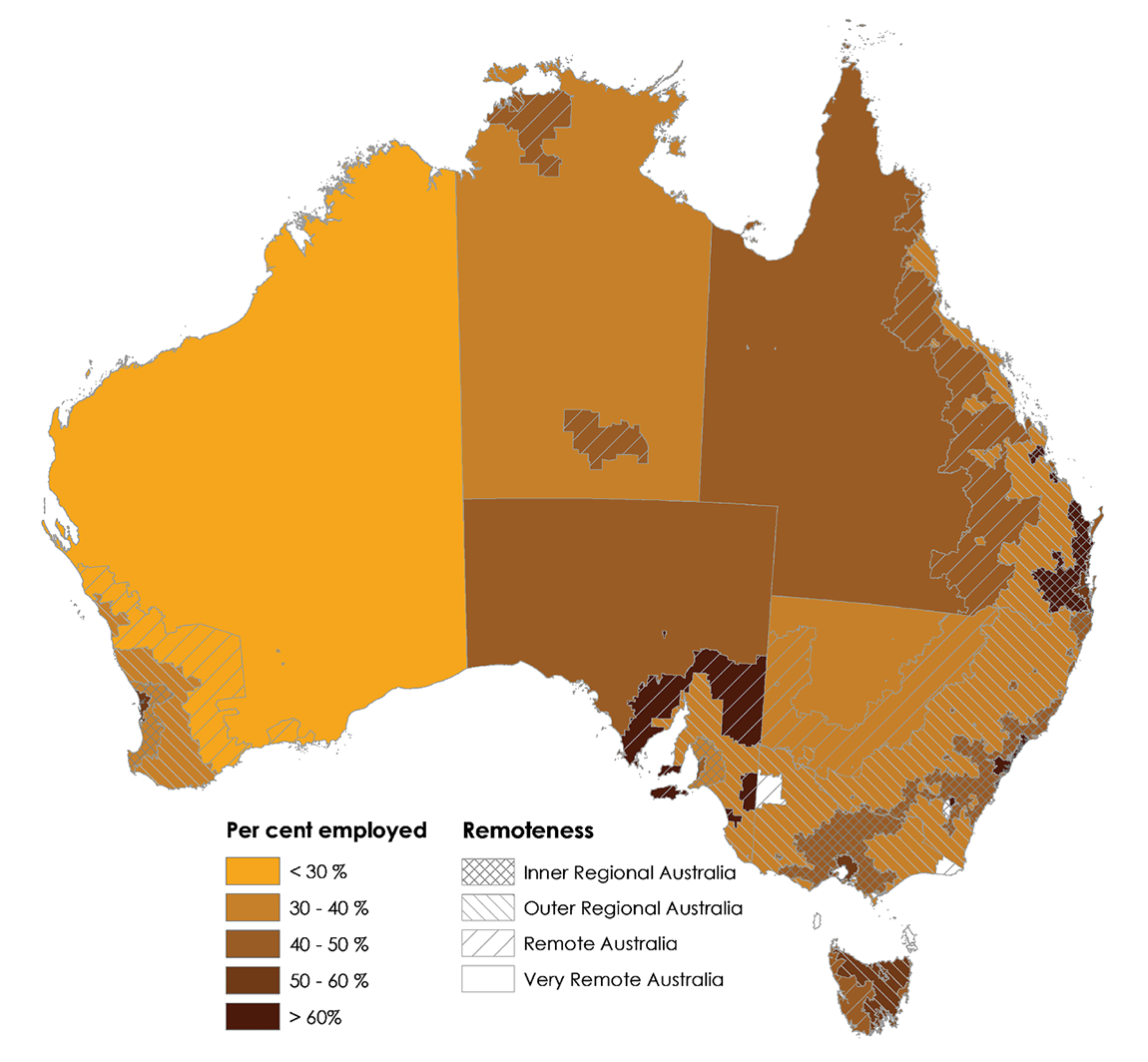
Source: Australian Bureau of Statistics, 2019, Australian Aboriginal and Torres Strait Islander Health Survey 2018–19, Cat. no. 4715.0, ABS: Canberra.
Note:
- The Relative Standard Error (RSE) for Indigenous estimates in Inner Regional Western Australia, Outer Regional Victoria and South Australia, and Remote Tasmania all exceed 25 per cent. Estimates with RSEs of 25 per cent or greater should be used with caution.
View the text alternative for Figure 6.6.
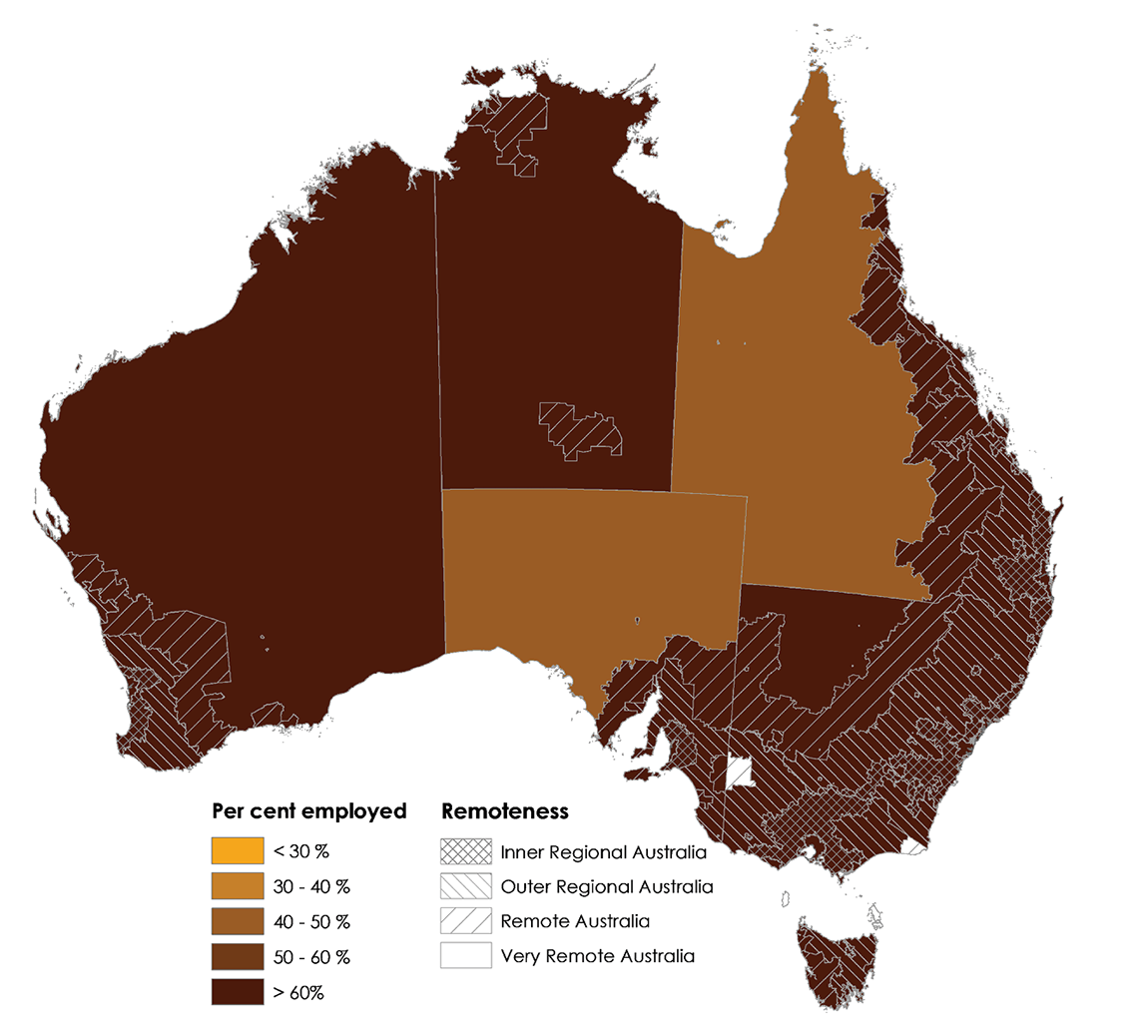
Source: Australian Bureau of Statistics, 2018, Education and Work, Australia, May 2018, Cat. no. 6227.0, ABS: Canberra.
Note:
- The RSE for non-Indigenous Australians in Remote Queensland, South Australia and Western Australia and Very Remote Northern Territory all exceed 25%. Estimates with RSEs of 25 per cent or greater should be used with caution.
View the text alternative for Figure 6.7.
[1] NATSIHS is the primary data source for the employment target, and Census data are supplementary when current. Survey data are not directly comparable with Census data. See the Technical Appendix for further information.
[2] The CDP is delivered in 60 regions and more than 1,000 communities.
[3] These results are not statistically significant.
[4] Comparisons with non-Indigenous Australians for this target are sourced from the ABS Survey of Education and Work.
[5] This is based on previous analysis of the 2014–15 National Aboriginal and Torres Strait Islander Social Survey. This was not included in the 2018–19 NATSIHS. Characteristics of Indigenous Australians with higher education (e.g. age, experience and field of study) may be different to Indigenous Australians who attain higher levels of education in the future, and their employment outcomes may also be different.
[6] The results for the Northern Territory are not statistically significant.
[7] These results are not statistically significant.
[8] These results are not statistically significant.
[9] Data in this section have been adjusted to exclude CDEP participants, due to the reasons outlined above.
[10] These results are not statistically significant.
[11] Figures serve as an indication of variation in outcomes across Australia.
